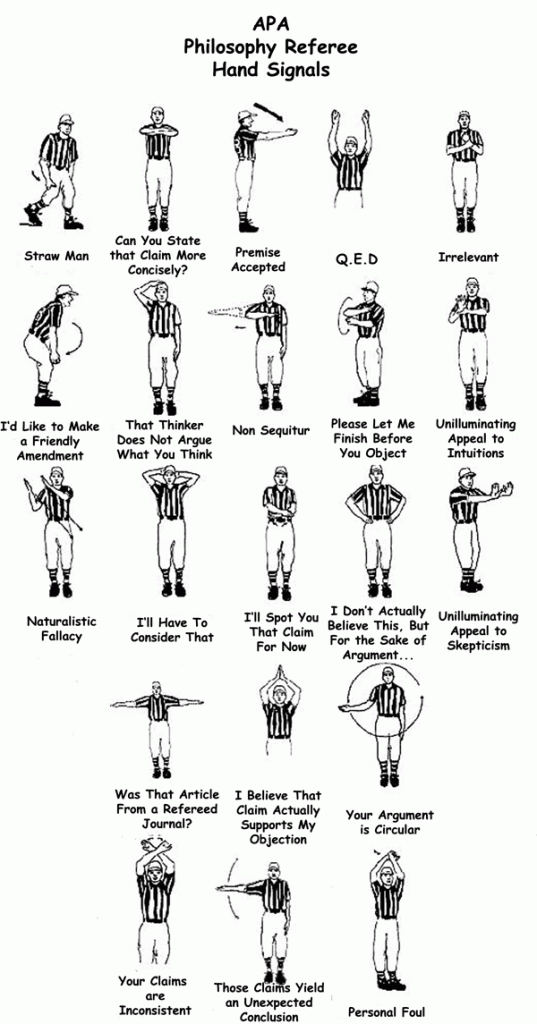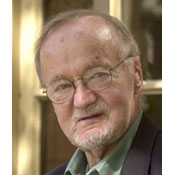Jane Gregory, speaking in 2004, on the necessary conditions for a public sphere:
To qualify as a public, a group of people needs four characteristics. First, it should be open to all and any: there are no entry qualifications. Secondly, the people must come together freely. But it is not enough to simply hang out – sheep do that. The third characteristic is common action. Sheep sometimes all point in the same direction and eat grass, but they still do not qualify as a public, because they lack the fourth characteristic, which is speech. To qualify as a public, a group must be made up of people who have come together freely, and their common action is determined through speech: that is, through discussion, the group determines a course of action which it then follows. When this happens, it creates a public sphere.
There is no public sphere in a totalitarian regime – for there, there is insufficient freedom of action; and difference is not tolerated. So there are strong links between the idea of a public sphere and democracy.”
I would add that most totalitarian states often force their citizens to participate in public events, thus violating two basic human rights: the right not to associate and the right not to listen.
I am reminded of a moment of courage on 25 August 1968, when seven Soviet citizens, shestidesiatniki (people of the 60s), staged a brave public protest at Lobnoye Mesto in Red Square, Moscow, at the military invasion of Czechoslovakia by forces of the Warsaw Pact. The seven (and one baby) were: Konstantin Babitsky (mathematician and linguist), Larisa Bogoraz (linguist, then married to Yuli Daniel), Vadim Delone (also written “Delaunay”, language student and poet), Vladimir Dremlyuga (construction worker), Victor Fainberg (mathematician), Natalia Gorbanevskaya (poet, with baby), and Pavel Litvinov (mathematics teacher, and grandson of Stalin’s foreign minister, Maxim Litvinov). The protest lasted only long enough for the 7 adults to unwrap banners and to surprise onlookers. The protesters were soon set-upon and beaten by “bystanders” – plain clothes police, male and female – who then bundled them into vehicles of the state security organs. Ms Gorbanevskaya and baby were later released, and Fainberg declared insane and sent to an asylum.
The other five faced trial later in 1968, and were each found guilty. They were sent either to internal exile or to prison (Delone and Dremlyuga) for 1-3 years; Dremlyuga was given additional time while in prison, and ended up serving 6 years. At his trial, Delone said that the prison sentence of almost three years was worth the “five minutes of freedom” he had experienced during the protest.
Delone (born 1947) was a member of a prominent intellectual family, great-great-great-grandson of a French doctor, Pierre Delaunay, who had resettled in Russia after Napoleon’s defeat. Delone was the great-grandson of a professor of physics, Nikolai Borisovich Delone (grandson of Pierre Delaunay), and grandson of a more prominent mathematician, Boris Nikolaevich Delaunay (1890-1980), and son of physicist Nikolai Delone (1926-2008). In 1907, at the age of 17, Boris N. Delaunay organized the first gliding circle in Kiev, with his friend Igor Sikorski, who was later famous for his helicopters. B. N. Delaunay was also a composer and artist as a young man, of sufficient talent that he could easily have pursued these careers. In addition, he was one of the outstanding mountaineers of the USSR, and a mountain and other features near Mount Belukha in the Altai range are named for him.
Boris N. Delaunay was primarily a geometer – although he also contributed to number theory and to algebra – and invented Delaunay triangulation. He was a co-organizer of the first Soviet Mathematics Olympiad, a mathematics competition for high-school students, in 1934. One of his students was Aleksandr D. Alexandrov (1912-1999), founder of the Leningrad School of Geometry (which studies the differential geometry of curvature in manifolds, and the geometry of space-time). Vadim Delone also showed mathematical promise and was selected to attend Moskovskaya Srednyaya Fiz Mat Shkola #2, Moscow Central Special High School No. 2 for Physics and Mathematics (now the Lyceum “Second School”). This school, established in 1958 for mathematically-gifted teenagers, was famously liberal and tolerant of dissent. (Indeed, so much so that in 1971-72, well after Delone had left, the school was purged by the CPSU. See Hedrick Smith’s 1975 account here. Other special schools in Moscow focused on mathematics are #57 and #179. In London, in 2014, King’s College London established a free school, King’s Maths School, modelled on FizMatShkola #2.) Vadim Delone lived with Alexandrov when, serving out a one-year suspended sentence which required him to leave Moscow, he studied at university in Novosibirsk, Siberia. At some risk to his own academic career, Alexandrov twice bravely visited Vadim Delone while he was in prison.
Delone’s wife, Irina Belgorodkaya, was also active in dissident circles, being arrested both in 1969 and again in 1973, and was sentenced to prison terms each time. She was the daughter of a senior KGB official. After his release in 1971 and hers in 1975, Delone and his wife emigrated to France in 1975, and he continued to write poetry. In 1983, at the age of just 35, he died of cardiac arrest. Given his youth, and the long lives of his father and grandfather, one has to wonder if this event was the dark work of an organ of Soviet state security. According to then-KGB Chairman Yuri Andropov’s report to the Central Committee of the CPSU on the Moscow Seven’s protest in September 1968, Delone was the key link between the community of dissident poets and writers on the one hand, and that of mathematicians and physicists on the other. Andropov even alleges that physicist Andrei Sakharov’s support for dissident activities was due to Delone’s personal persuasion, and that Delone lived from a so-called private fund, money from voluntary tithes paid by writers and scientists to support dissidents. (Sharing of incomes in this way sounds suspiciously like socialism, which the state in the USSR always determined to maintain a monopoly of.) That Andropov reported on this protest to the Central Committee, and less than a month after the event, indicates the seriousness with which this particular group of dissidents was viewed by the authorities. That the childen of the nomenklatura, the intelligentsia, and even the KGB should be involved in these activities no doubt added to the concern. If the KGB actually believed the statements Andropov made about Delone to the Central Committee, they would certainly have strong motivation to arrange his early death.
Several of the Moscow Seven were honoured in August 2008 by the Government of the Czech Republic, but as far as I am aware, no honour or recognition has yet been given them by the Soviet or Russian Governments. Although my gesture will likely have little impact on the world, I salute their courage here.
I have translated a poem of Delone’s here. An index to posts on The Matherati is here.
References:
M. V. Ammosov [2009]: Nikolai Borisovich Delone in my Life. Laser Physics, 19 (8): 1488-1490.
Yuri Andropov [1968]: The Demonstration in Red Square Against the Warsaw Pact Invasion of Czechoslovakia. Report to the Central Committee of the CPSU, 1968-09-20. See below.
N. P. Dolbilin [2011]: Boris Nikolaevich Delone (Delaunay): Life and Work. Proceedings of the Steklov Institute of Mathematics, 275: 1-14. Published in Russian in Trudy Matematicheskogo Instituta imeni V. A. Steklov, 2011, 275: 7-21. Pre-print here.
Jane Gregory [2004]: Subtle signs that divide the public from the private. The Independent, 2004-05-20.
Hedrick Smith [1975]: The Russians. Crown. pp. 211-213.
APPENDIX
Andropov Reoport to the Central Committee of the CPSU on the protests in Red Square. (20 September 1968)
In characterizing the political views of the participants of the group, in particular DELONE, our source notes that the latter, “calling himself a bitter opponent of Soviet authority, fiercely detests communists, the communist ideology, and is entirely in agreement with the views of Djilas. In analyzing the activities . . . of the group, he (DELONE) explained that they do not have a definite program or charter, as in a formally organized political opposition, but they are all of the common opinion that our society is not developing normally, that it lacks freedom of speech and press, that a harsh censorship is operating, that it is impossible to express one’s opinions and thoughts, that democratic liberties are repressed. The activity of this group and its propaganda have developed mainly within a circle of writers, poets, but it is also enveloping a broad circle of people working in the sphere of mathematics and physics. They have conducted agitation among many scholars with the objective of inducing them to sign letters, protests, and declarations that have been compiled by the more active participants in this kind of activity, Petr IAKIR and Pavel LITVINOV. These people are the core around which the above group has been formed . . .. IAKIR and LITVINOV were the most active agents in the so-called “samizdat.”
This same source, in noting the condition of the arrested DELONE in this group, declared: “DELONE . . . has access to a circle of prominent scientists, academicians, who regarded him as one of their own, and in that way he served . . . to link the group with the scientific community, having influence on the latter and conducting active propaganda among them. Among his acquaintances he named academician Sakharov, who was initially cautious and distrustful of the activities of IAKIR, LITVINOV, and their group; he wavered in his position and judgments, but gradually, under the influence of DELONE’s explanations, he began to sign various documents of the group. . . ; [he also named] LEONTOVICH, whose views coincide with those of the group. In DELONE’s words, many of the educated community share their views, but are cautious, fearful of losing their jobs and being expelled from the party.” . . . [more details on DELONE]
Agents’ reports indicate that the participants of the group, LITVINOV, DREMLIUGA, AND DELONE, have not been engaged in useful labor for an extended period, and have used the means of the so-called “private fund,” which their group created from the contributions of individual representatives in the creative intelligentsia and scientists.
The prisoner DELONE told our source: “We are assisted by monetary funds from the intelligentsia, highly paid academicians, writers, who share the views of the Iakir-Litvinov group . . . [Sic] We have the right to demand money, [because] we are the functionaries, while they share our views, [but] fear for their skins, so let them support us with money.”

